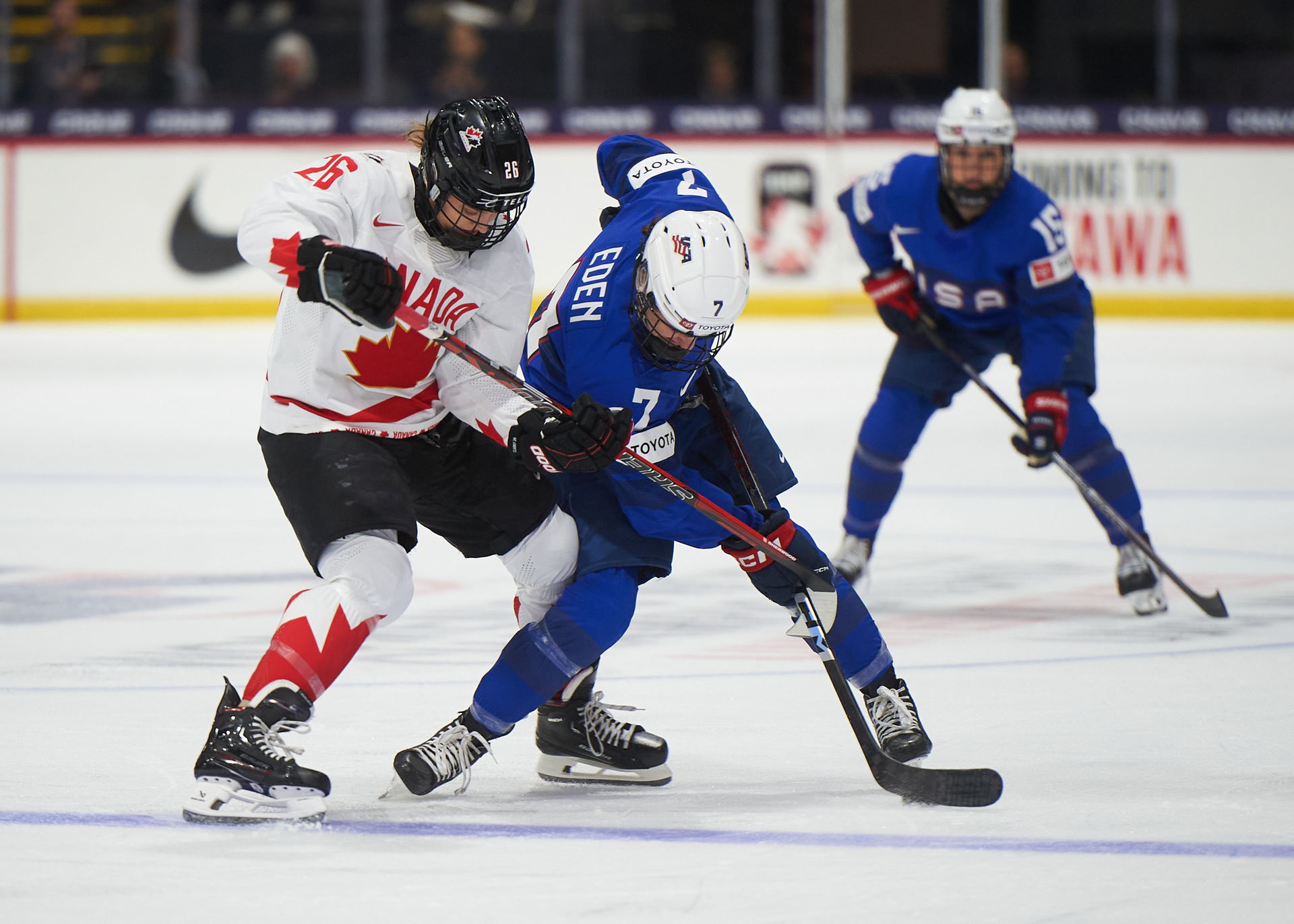
Head-To-Head: Comparing Canada and USA's World Championship Rosters
 Emily Clark and Lacey Eden fight for the puck at the 2024 World Championships - Photo @ Ellen Bond
Emily Clark and Lacey Eden fight for the puck at the 2024 World Championships - Photo @ Ellen BondIn recent years, Canada and USA have fielded two vastly different rosters. Canada has brought veteran laden lineups, with few NCAA players. USA has brought younger rosters filled with college players, and anchored by veterans.
This year however, both nations moved more toward a middle ground. Both have composed more balanced lineups than we’ve seen in the past. For the first time in years, Canada is bringing a plethora of fresh faces.
Goaltending Shuffles For Both
It’s still Aerin Frankel versus Ann-Renee Desbiens. But as we’ve seen in recent weeks, the top goalies in the PWHL are neither infallible, or untouchable. With Emerance Maschmeyer and Ann-Renee Desbiens both facing injuries, it opens the door for USA offensively, or for another Canadian goalie to step forward. Eve Gascon is the heir apparent to Canada’s crease, but she’s still a few seasons away from the pro game, and Canada is ofter overcautious when it comes to giving young players opportunities. Kristen Campbell is a wild card. On one hand she is the reigning PWHL Goaltender of the Year. On the other hand, her Rivalry Series games and Team Canada camp games have been abysmal. If Canada needs her, which Kristen Campbell will show up? If Desbiens is healthy, she’s been riding one of her best campaigns in recent memory.
At the other end of the ice, Aerin Frankel remains one of the world’s elite netminders. It’s a point that cannot be argued. Behind her is Gwyneth Philips, and Ava McNaughton. Considering each goalie in USA’s crease has been named the NCAA Goaltender of the Year, including McNaughton with Wisconsin this year, USA’s depth is impressive.
Edge? USA.
Defensive Depth, Back End Threats
Canada and USA enter with incredibly deep bluelines. Canada brings Renata Fast, Erin Ambrose, Claire Thompson, Ella Shelton, Sophie Jaques, Micah Zandee-Hart, Jocelyne Larocque, and teen phenom Chloe Primerano. USA’s blueline features Megan Keller, Cayla Barnes, Caroline Harvey, Savannah Harmon, Lee Stecklein, Haley Winn, Anna Wilfred, and the reigning World Championship MVP, who spent last season at forward, Laila Edwards. USA added some shutdown elements in Stecklein and Wilfred, while Canada added offensive dynamism. Both bluelines are all-world in calibre. In fact, Canada had to cut defenders who could slot into the top four on any other nation in the world outside of USA’s own roster.
Edge? Canada
Will is be another high scoring final?
Few expected a 6-5 overtime gold medal game. Canada and USA are more often playing 2-1 or 3-2 games. Last year however, the floodgates opened and it was all about scoring. On either side of the ice, Marie-Philip Poulin and Hilary Knight will square off as legend against legend. USA has a lot of punch up front in NCAA players Abbey Murphy, Tessa Janecke, Joy Dunne, and Kirsten Simms. Their speed and skill on the puck however, continues with pros Alex Carpenter, Taylor Heise, and Kendall Coyne Schofield. There’s a small drop after this core, especially considering the slow year two-way veterans like Kelly Pannek and Hayley Scamurra have had.
Canada will feature wave after wave of attacks. From Poulin and Laura Stacey, Daryl Watts and Hannah Miller, Natalie Spooner and Sarah Nurse, to Sarah Nurse and Danielle Serdachny. Due to the top end talent Canada wields, they could conceivably push stars including Brianne Jenner and Emma Maltais to their fourth line to attempt to capitalize off mismatches. Their newcomers are potent scorers, that will make it more difficult for opponents, including the USA, to match up.
Edge? Canada